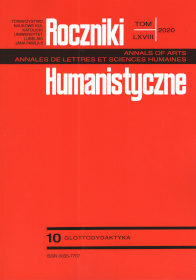Избранные аспекты теории и практики преподавания аудиовизуального перевода на польских неофилологических направлениях
Abstrakt
Wybrane zagadnienia z teorii i praktyki nauczania tłumaczenia audiowizualnego na polskich kierunkach neofilologicznych
Tłumaczenie audiowizualne (ang. AVT) jest obecnie najbardziej dynamicznie rozwijającym się rodzajem tłumaczenia. Według autorów niniejszego artykułu ten typ tłumaczeń będzie zyskiwać na popularności. Niestety, w ramach współczesnych polskich neofilologii zajęcia z AVT jeszcze nie weszły do siatki stałych przedmiotów. Artykuł ma za zadanie zwrócić uwagę środowiska akademickiego na konieczność wprowadzenia zajęć z AVT do siatki programowej. W artykule są omawiane najnowsze tendencje teoretyczne rozwoju AVT oraz prezentowane najbardziej popularne techniki tłumaczenia tego typu, które mogą być z powodzeniem wykorzystywane w procesie nauki języków obcych na kierunkach neofilologicznych. Należą do nich przede wszystkim tworzenie napisów oraz dubbing. Artykuł ostatecznie odpowiada na główne pytanie, w jaki sposób można wykorzystać ten rodzaj tłumaczenia na zajęciach i jakie efekty glottodydaktyczne można w ten sposób osiągnąć.
Избранные аспекты теории и практики преподавания аудиовизуального перевода на польских неофилологических направлениях
Аудиовизуальный перевод (анг. audiovisual translation, АVТ) это наиболее динамично развивающийся вид перевода современной эпохи. По мнению авторов статьи, популярность этого вида перевода будет только расти. К сожалению, на польских неофилологических направлениях занятия по аудиовизуальному переводу еще не вошли в учебные программы в качестве обязательных предметов. Цель настоящей статьи – привлечь внимание академического сообщества к необходимости включения курсов перевода AVT в учебные программы. В статье рассматриваются тенденции развития АVT и самые популярные техники аудиовизуального перевода: субтитрование и дубляж, которые могут быть успешно использованы в процессе обучения иностранным языкам. Авторы статьи дают рекомендации по способам использования данного типа перевода на занятиях и отвечают на вопрос, какого дидактического эффекта можно достичь благодаря его применению.
Bibliografia
Chaume, Frederic. «Synchronization in Dubbing: A Translational Approach». Topics in audiovisual translation, ed. Pilar Orero, John Benjamins Publishing Company, 2004, cc. 35-52.
Díaz Cintas, Jorge, editor. New trends in audiovisual translation. Multilingual Matters, 2009.
Franco, Eliana, Anna Matamala, and Pilar Orero. Voice Over Translation: An Overview. Peter Lang, 2010.
Gambier, Yves. «The position of audiovisual translation studies». The Routledge handbook of translation studies, ed. Millán Carmen, and Francesca Bartrina, Taylor and Francis, 2013.
Garcarz, Michał. Przekład slangu w filmie. Tertium, 2007.
Gorshkova, Vera. Perevod v kino. IGLU, 2006 [Горшкова, Вера. Перевод в кино. ИГЛУ, 2006].
Hendrykowski, Marek. «Z problemów przekładu filmowego». Wielojęzyczność literatury i problemy przekładu artystycznego, red. Edward Balcerzan, Ossolineum, 1984.
Jakobson, Roman. «On Linguistic Aspects of Translation». On translation, ed. Ross Brower, Harvard University Press, 1959.
Kornaukhova, Nataliya. «Audiovizual’nyy perevod v usloviyakh novoy tekhnologicheskoy re-al’nosti». Nauchnaya diskussiya: voprosy filologii, iskusstvovedeniya i kul’turologii. Internauka, 2016 [Корнаухова, Наталия. «Аудиовизуальный перевод в условиях новой технологической реальности». Научная дискуссия: вопросы филологии, искусствоведения и культурологии. Интернаука, 2016].
Sikora, Iwona. Dubbing filmów animowanych. Oficyna Wydawnicza pwsz, 2013.
Taylor, Christopher. «Multimodality and audiovisual translation». Handbook of Translation Studies. Vol 4, red. Yves Gambier and Luc Doorslaer, John Benjamins Publishing Company, 2013.
Tomaszkiewicz, Teresa. «Przekład audiowizualny, werbo-wizualny czy intersemiotyczny: różne wymiary tej samej rzeczywistości?». Lingwistyka Stosowana, vol. 3, 2010, cc. 33-44.
Tomaszkiewicz, Teresa. Przekład audiowizualny. Wydawnictwo Naukowe PWN, 2006.
Copyright (c) 2020 Roczniki Humanistyczne

Utwór dostępny jest na licencji Creative Commons Uznanie autorstwa – Użycie niekomercyjne – Bez utworów zależnych 4.0 Międzynarodowe.





